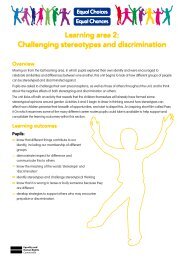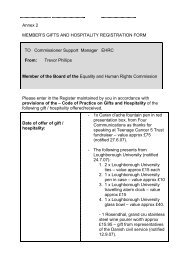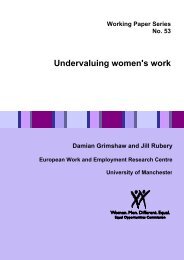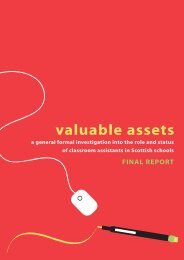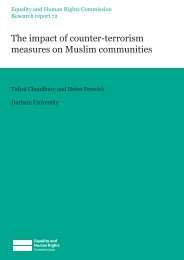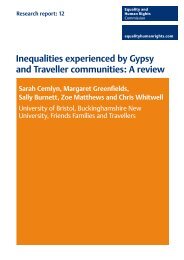Chapter 10: Education - Equality and Human Rights Commission
Chapter 10: Education - Equality and Human Rights Commission
Chapter 10: Education - Equality and Human Rights Commission
You also want an ePaper? Increase the reach of your titles
YUMPU automatically turns print PDFs into web optimized ePapers that Google loves.
<strong>Chapter</strong> <strong>10</strong>: <strong>Education</strong> 321<br />
Disability<br />
Young people with a disability or SEN were most at risk of being bullied. More<br />
than four-fifths of young people with a statement of SEN (83%) or a disability that<br />
affected their schooling (81%) reported having been bullied in 2004-06, compared<br />
to under two-thirds (65%) of young people with no SEN or no disability. 48<br />
According to qualitative research with 507 children <strong>and</strong> young people in Engl<strong>and</strong><br />
<strong>and</strong> Wales, young people with learning disabilities are particularly at risk with<br />
82% of those sampled reporting having being bullied. 49 Of those, 8 out of <strong>10</strong><br />
children <strong>and</strong> young people had experienced bullying at school <strong>and</strong> 3 out of <strong>10</strong> were<br />
bullied out on the street, at the park or on the bus. 50<br />
However, survey evidence from teachers suggests while a quarter of secondary<br />
school teachers (<strong>and</strong> 17% of all teachers) recognise that pupils with disabilities are<br />
bullied by other pupils, overall, teachers feel that students with SEN are the most<br />
supported group in school. 51<br />
Ethnicity<br />
According to the Youth Cohort Study <strong>and</strong> the Longitudinal Study of Young People,<br />
White pupils were most likely to report being bullied, with around two-thirds<br />
(67%) of White pupils reporting being bullied between 2004-06. Mixed Race<br />
pupils (66%), Black African (62%) <strong>and</strong> Black Caribbean pupils (61%) also reported<br />
relatively high rates of bullying compared to Pakistani (58%), Bangladeshi (52%)<br />
<strong>and</strong> Indian pupils (49%). 52<br />
<strong>Chapter</strong> <strong>10</strong><br />
Religion or belief<br />
The school experiences of pupils of different religions <strong>and</strong> beliefs are not reflected<br />
in large-scale datasets, <strong>and</strong> there is limited evidence available on bullying from<br />
this perspective. However, one survey of over 1,000 pupils in 2007 suggests that it<br />
is an issue. The survey found that 23% of young people sampled, who practiced<br />
any religion in Engl<strong>and</strong>, reported being bullied because of their faith. 53<br />
48<br />
DCSF 2008. Section 3: Stay Safe.<br />
49<br />
Mencap 2006. Bullying wrecks lives: the experiences of children <strong>and</strong> young<br />
people with a learning disability. Page 3. Available at: http://www.mencap.<br />
org.uk/displaypagedoc.asp?id=164 Qualitative research with 507 children<br />
<strong>and</strong> young people with a learning disability aged between 8 <strong>and</strong> 19 years.<br />
60% of respondents were boys <strong>and</strong> 6% were from Black or ethnic minority<br />
backgrounds.<br />
50<br />
Mencap 2006. Page 6.<br />
51<br />
NFER 20<strong>10</strong>.<br />
52<br />
DCSF 2008. Section 3: Stay Safe.<br />
53<br />
Interfaith report 2008. Beat Bullying. London: Interfaith. Page 5. Based on<br />
responses from over 1,000 young people either to a surveyor or through focus<br />
groups.




